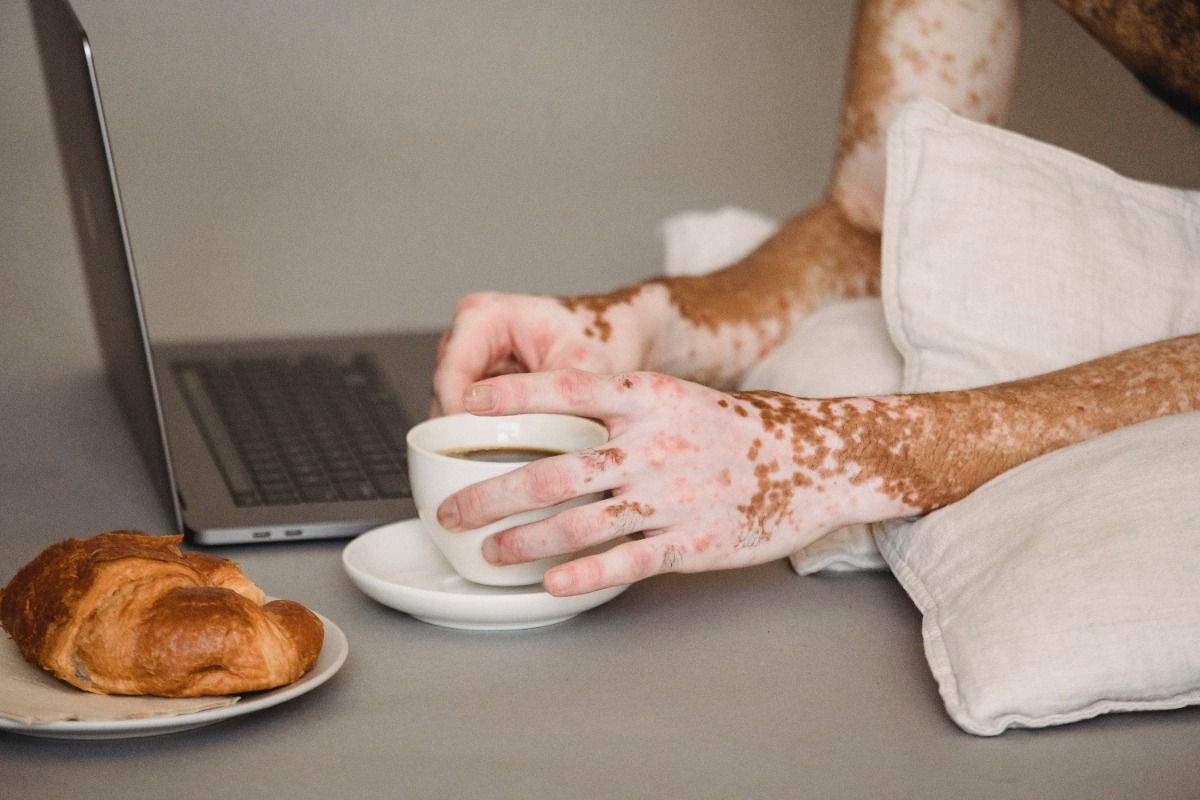
Vitiligo is a chronic skin condition where pale white patches of skin develop on a person’s body due to lost skin pigment. If your skin is losing colour pigment in patches, you might have Vitiligo. This skin condition can happen to anyone of any age, gender, or ethnicity. Pale patches form on the skin when melanocytes in the skin die. Melanocytes are the cells responsible for creating melanin, which gives skin its colour and protects it from UV rays.
This is why those with Vitiligo are at higher risk for sunburns and skin cancer.
The total area of skin on the body that can be affected by Vitiligo varies from person to person. It can also cause problems with the eyes, the inside of the mouth, and the hair. The damaged portions of the skin are often stained for the remainder of the person’s life. The colour of the affected areas of the skin does not typically become restored back to normal.
This disease is photosensitive. Afflicted areas will be more sensitive to sunlight than unaffected areas of the body. Those with Vitiligo should apply sunscreen daily. It is difficult to predict how far Vitiligo will spread. People with darker skin tones tend to have more noticeable Vitiligo, as the lighter patches of skin are more noticeable.
Vitiligo is not a painful condition. Sunburns on lighter regions of skin, on the other hand, can be painful. By staying out of the sun during peak hours, wearing sunscreen all year long and wearing protective clothing, sunburns can be avoided. Some Vitiligo patients have experienced itching skin at times, and this is normal for those with this skin condition.
Signs and Symptoms of Vitiligo
The most obvious symptom of Vitiligo is white or pale spots on the skin. These patches are typically more common in sun-exposed regions of the skin. Patches on the hands, feet, arms, face, and lips are all possible. Other typical locations for pale patches of skin include:
- Armpits and groin (where the legs meet the torso)
Nostrils
- Navel
- Rectal regions
- Eyes
- Genitals
Vitiligo patients frequently develop greying hair at a young age. Individuals with darker complexions may notice a loss of colour inside their mouths.

What Causes Vitiligo?
Although the causes of Vitiligo are not fully known, there are several theories:
- Autoimmune disorder: The immune system of the afflicted person may produce antibodies that kill melanocytes.
- Skin damage: Sunburns, wounds or abrasions could cause pigment cells to be destroyed and not replenished. Melanocytes sometimes destroy themselves due to a flaw or wound on the skin.
- Genetics: Certain variables that may enhance the likelihood of developing Vitiligo can be inherited. About 30% of Vitiligo cases are hereditary.
- Neurogenic factors: A harmful material to melanocytes may be produced at skin nerve terminals.
- Stress: Physical or mental stress could cause or contribute to Vitiligo.
What Are Some Health Complications of Vitiligo?
Although Vitiligo is mostly thought of as a cosmetic or aesthetic disorder, those who have it may face several other issues, aside from physical appearance issues:
- Vitiligo patients may have some abnormalities in their retinas (the inner layer of the eye that includes light-sensitive cells) as well as some color fluctuation in their irises (the colored part of the eye). There may be some inflammation of the retina or iris in some cases, but vision is usually unaffected.
- Other autoimmune diseases (in which the body’s immune system attacks itself) such as alopecia areata, Addison’s disease, hypothyroidism, pernicious anemia, and diabetes may be more common in people with Vitiligo. Vitiligo is also more common in people who have autoimmune diseases.
- Mental health: Vitiligo patients may be self-conscious or anxious about their skin. People can be cruel, either by staring or saying hurtful things. A person with Vitiligo may struggle with mental health and self-esteem as a result of their skin condition. This, in turn, could lead to anxiety or depression, as well as a desire to withdraw from social situations. Working on confidence, self-love and going to counselling could help Vitiligo patients.
What Are The Different Kinds Of Vitiligo?
Below are some variations of Vitiligo:
- Segmental is a variation of Vitiligo that affects only one side of the body or a specific region, such as only affecting the hands or face.
- Mucosal, which affects the mouth and genital mucous membranes.
- Focal is an uncommon variety in which the macules are concentrated in a limited region and do not spread predictably over one to two years.
- Trichome implies a white or colorless core, followed by a lighter pigmented region, and finally a normal-colored area.
- Macules occur in numerous areas of the body in generalized macules, which is the most frequent kind.
Diagnosis and Treatment
Treatment of Vitiligo, if effective, may aid in the appearance of a more even skin tone. Treatment options are determined by:
- The number of pale patches there are on the patient’s body
- The size of the patches
- The method of therapy that the patient is comfortable with
Some therapies are not suitable for all patients. Many medications have unintended side effects. Treatments might take a long time to work, and they aren’t always effective. Medications and light-based treatments are available to help restore skin colour or level out skin tone; however, outcomes vary and are unpredictable. Furthermore, some therapies have severe adverse effects. As a result, your doctor may advise that you initially attempt altering the look of your skin using self-tanning productsor cosmetics that cover the Vitiligo patches.
If you and your doctor decide to use medication, surgery, or treatment to address your illness, the evaluation process could take months. You also may have to try a few different treatments or a mix of treatments before you find the one that works best for you.
Even if treatment is effective for a short period of time, the benefits may not last, or new patches could emerge.
Vitiligo Medications
There is no cure for Vitiligo, which again is characterized by losing pigment cells (melanocytes). However, when used alone, in combination, or in conjunction with light treatment, several medications can aid in the restoration of skin pigment.
- Inflammation-controlling medications. A corticosteroid cream applied to the afflicted skin may help to restore color. When Vitiligo is still in its early stages, this is the most effective treatment. Although this sort of cream is effective and simple to apply, you may not see any changes in your skin color for several months. Skin thinning or the development of streaks or lines on your skin are possible adverse effects. Children and people with large areas of discolored skin may be prescribed milder versions of the drug. For those whose health is quickly worsening, corticosteroid tablets or injections may be an option.
- Immune-suppressing medications are those that affect the immune system. Calcineurin inhibitor ointments such tacrolimus (Protopic) or pimecrolimus (Elidel) may help patients with tiny patches of depigmentation, notably on the face and neck. The Food and Drug Administration (FDA) in the United States has issued a warning regarding a possible relationship between these medications and lymphoma and skin cancer.”

Alternate Treatments and Therapies
Light therapy is one of the treatments available for Vitiligo. Active Vitiligo can be treated using narrow-band ultraviolet B (UVB) phototherapy, which has been demonstrated to stop or reduce the development of the disease. When used with corticosteroids or calcineurin inhibitors, it may be more effective. Two to three times a week, you’ll need treatment. It may take one to three months to see a difference, and it may take six months or longer to see the full impact.
Given the FDA’s warning concerning the risk of skin cancer from calcineurin inhibitors, discuss the risks and advantages of using these medicines with phototherapy with your doctor. Redness, itching, and burning are all possible adverse effects of narrow-band ultraviolet B treatment. After treatment, these adverse effects generally go away within a few hours.
Using psoralen in conjunction with light treatment: This treatment combines a plant-derived chemical called psoralen with light therapy (photochemotherapy) to restore colour to the light patches. You’re exposed to ultraviolet A (UVA) light after taking psoralen or applying it to the afflicted skin. While effective, this method is more difficult to implement, and narrow-band UVB treatment has largely supplanted it in many clinics.
Getting rid of the last bit of colour (depigmentation): If your Vitiligo is severe and previous treatments have failed, this therapy may be a possibility. Unaffected regions of the skin are treated with a depigmenting chemical. This lightens the skin over time, blending it in with the discoloured areas. For nine months or longer, the therapy is done once or twice a day.
Redness, swelling, itching, and very dry skin are all possible side effects of treatment. Depigmentation is a long-term process. Consult a doctor if you think you might have Vitiligo or another skin condition. If your skin problems grow extensive, create discomfort, or result in joint difficulties that interfere with everyday tasks, you should seek medical attention.
Being informed of your genetic propensity to skin diseases like Vitiligo, for example, might be beneficial. By reviewing your CircleDNA genetic skin profile, you’ll be able to see the skin disorders and skin conditions you’re genetically predisposed to if any.






